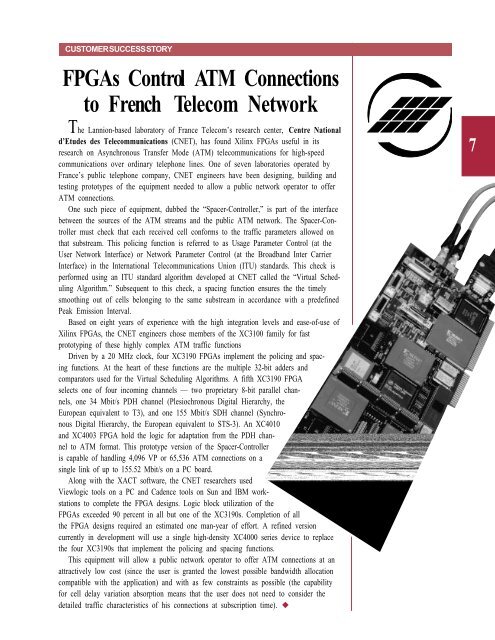Xcell on the Web - Xilinx
Xcell on the Web - Xilinx
Xcell on the Web - Xilinx
You also want an ePaper? Increase the reach of your titles
YUMPU automatically turns print PDFs into web optimized ePapers that Google loves.
CUSTOMER SUCCESS STORY<br />
FPGAs C<strong>on</strong>trol ATM C<strong>on</strong>necti<strong>on</strong>s<br />
to French Telecom Network<br />
The Lanni<strong>on</strong>-based laboratory of France Telecom’s research center, Centre Nati<strong>on</strong>al<br />
d’Etudes des Telecommunicati<strong>on</strong>s (CNET), has found <strong>Xilinx</strong> FPGAs useful in its<br />
research <strong>on</strong> Asynchr<strong>on</strong>ous Transfer Mode (ATM) telecommunicati<strong>on</strong>s for high-speed<br />
communicati<strong>on</strong>s over ordinary teleph<strong>on</strong>e lines. One of seven laboratories operated by<br />
France’s public teleph<strong>on</strong>e company, CNET engineers have been designing, building and<br />
testing prototypes of <strong>the</strong> equipment needed to allow a public network operator to offer<br />
ATM c<strong>on</strong>necti<strong>on</strong>s.<br />
One such piece of equipment, dubbed <strong>the</strong> “Spacer-C<strong>on</strong>troller,” is part of <strong>the</strong> interface<br />
between <strong>the</strong> sources of <strong>the</strong> ATM streams and <strong>the</strong> public ATM network. The Spacer-C<strong>on</strong>troller<br />
must check that each received cell c<strong>on</strong>forms to <strong>the</strong> traffic parameters allowed <strong>on</strong><br />
that substream. This policing functi<strong>on</strong> is referred to as Usage Parameter C<strong>on</strong>trol (at <strong>the</strong><br />
User Network Interface) or Network Parameter C<strong>on</strong>trol (at <strong>the</strong> Broadband Inter Carrier<br />
Interface) in <strong>the</strong> Internati<strong>on</strong>al Telecommunicati<strong>on</strong>s Uni<strong>on</strong> (ITU) standards. This check is<br />
performed using an ITU standard algorithm developed at CNET called <strong>the</strong> “Virtual Scheduling<br />
Algorithm.” Subsequent to this check, a spacing functi<strong>on</strong> ensures <strong>the</strong> <strong>the</strong> timely<br />
smoothing out of cells bel<strong>on</strong>ging to <strong>the</strong> same substream in accordance with a predefined<br />
Peak Emissi<strong>on</strong> Interval.<br />
Based <strong>on</strong> eight years of experience with <strong>the</strong> high integrati<strong>on</strong> levels and ease-of-use of<br />
<strong>Xilinx</strong> FPGAs, <strong>the</strong> CNET engineers chose members of <strong>the</strong> XC3100 family for fast<br />
prototyping of <strong>the</strong>se highly complex ATM traffic functi<strong>on</strong>s<br />
Driven by a 20 MHz clock, four XC3190 FPGAs implement <strong>the</strong> policing and spacing<br />
functi<strong>on</strong>s. At <strong>the</strong> heart of <strong>the</strong>se functi<strong>on</strong>s are <strong>the</strong> multiple 32-bit adders and<br />
comparators used for <strong>the</strong> Virtual Scheduling Algorithms. A fifth XC3190 FPGA<br />
selects <strong>on</strong>e of four incoming channels — two proprietary 8-bit parallel channels,<br />
<strong>on</strong>e 34 Mbit/s PDH channel (Plesiochr<strong>on</strong>ous Digital Hierarchy, <strong>the</strong><br />
European equivalent to T3), and <strong>on</strong>e 155 Mbit/s SDH channel (Synchr<strong>on</strong>ous<br />
Digital Hierarchy, <strong>the</strong> European equivalent to STS-3). An XC4010<br />
and XC4003 FPGA hold <strong>the</strong> logic for adaptati<strong>on</strong> from <strong>the</strong> PDH channel<br />
to ATM format. This prototype versi<strong>on</strong> of <strong>the</strong> Spacer-C<strong>on</strong>troller<br />
is capable of handling 4,096 VP or 65,536 ATM c<strong>on</strong>necti<strong>on</strong>s <strong>on</strong> a<br />
single link of up to 155.52 Mbit/s <strong>on</strong> a PC board.<br />
Al<strong>on</strong>g with <strong>the</strong> XACT software, <strong>the</strong> CNET researchers used<br />
Viewlogic tools <strong>on</strong> a PC and Cadence tools <strong>on</strong> Sun and IBM workstati<strong>on</strong>s<br />
to complete <strong>the</strong> FPGA designs. Logic block utilizati<strong>on</strong> of <strong>the</strong><br />
FPGAs exceeded 90 percent in all but <strong>on</strong>e of <strong>the</strong> XC3190s. Completi<strong>on</strong> of all<br />
<strong>the</strong> FPGA designs required an estimated <strong>on</strong>e man-year of effort. A refined versi<strong>on</strong><br />
currently in development will use a single high-density XC4000 series device to replace<br />
<strong>the</strong> four XC3190s that implement <strong>the</strong> policing and spacing functi<strong>on</strong>s.<br />
This equipment will allow a public network operator to offer ATM c<strong>on</strong>necti<strong>on</strong>s at an<br />
attractively low cost (since <strong>the</strong> user is granted <strong>the</strong> lowest possible bandwidth allocati<strong>on</strong><br />
compatible with <strong>the</strong> applicati<strong>on</strong>) and with as few c<strong>on</strong>straints as possible (<strong>the</strong> capability<br />
for cell delay variati<strong>on</strong> absorpti<strong>on</strong> means that <strong>the</strong> user does not need to c<strong>on</strong>sider <strong>the</strong><br />
detailed traffic characteristics of his c<strong>on</strong>necti<strong>on</strong>s at subscripti<strong>on</strong> time). ◆<br />
7

















